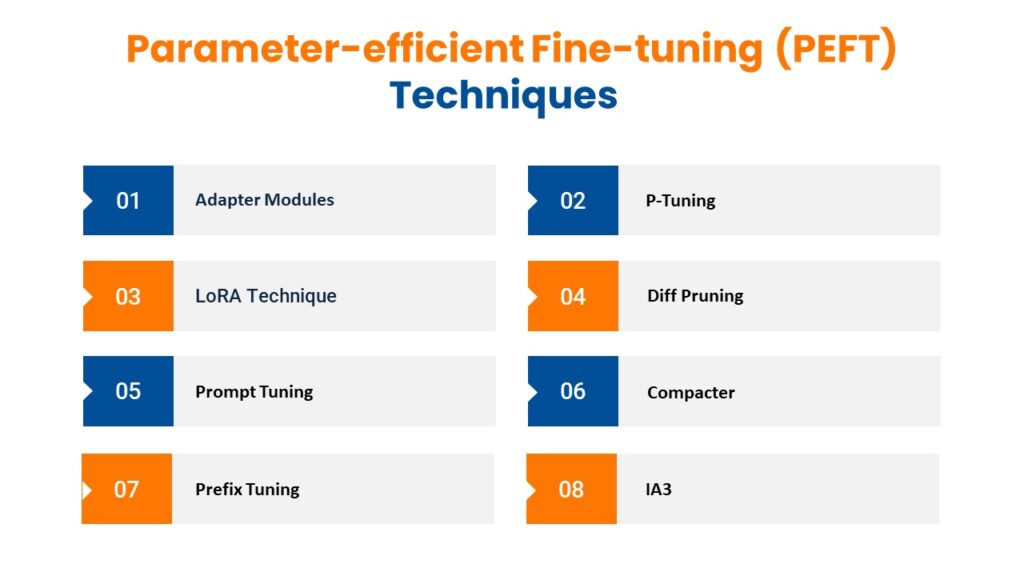How crucial is it to efficiently train large language models (LLMs) in today’s AI-driven world? Fine-tuning an LLM like GPT-4 can require terabytes of data and extensive computational power, making it both costly and resource-intensive. Parameter-Efficient Fine-Tuning (PEFT), a game-changing approach that reduces these demands while maintaining performance.
Parameter-efficient Fine-tuning (PEFT) is a technique used to fine-tune pre-trained language models (PLMs) to various downstream applications. It is an efficient way to adapt large language models to specific tasks without having to fine-tune all the model’s parameters. PEFT methods address the issue of catastrophic forgetting in large models and enable fine-tuning with limited computing.
Understanding Parameter-Efficient Fine-Tuning is essential for anyone looking to optimize their Gen AI strategy. By only fine-tuning a small number of extra parameters while freezing most of the pre-trained model, PEFT prevents catastrophic forgetting in large models and enables fine-tuning with limited computing. PEFT approaches only fine-tune a small number of extra model parameters while freezing most parameters of the pre-trained LLMs, thereby greatly decreasing the computational and storage costs.
Table of Contents
- What is Parameter-efficient Fine-tuning (PEFT)?
- What are the Differences Between Fine-tuning and PEFT?
- Large Language Models and PEFT
- 8 Key Parameter-efficient Fine-tuning Techniques
- Benefits of Parameter-Efficient Fine-Tuning
- Training Your Model with PEFT: A Step-by-Step Guide
- Computational Aspects of PEFT
- Pitfalls to avoid in PEFT
- Uses Cases of Parameter-Efficient Fine-Tuning (PEFT)
- Kanerika’s AI Solutions: Revolutionizing Business Efficiency with Advanced LLMs
- FAQs
What is Parameter-efficient Fine-tuning (PEFT)?
If you’re familiar with transfer learning, you know that it’s a powerful technique that allows you to leverage pre-trained models to solve a wide range of downstream tasks. However, fine-tuning these models can be computationally expensive, especially when dealing with large models like GPT-3 or BERT that have billions of parameters.
This is where Parameter-efficient Fine-tuning (PEFT) comes in. PEFT is a set of techniques that propose to fine-tune large pre-trained models using a small subset of parameters while preserving most of the original pre-trained weights fixed. By fine-tuning only a small subset of the model’s parameters, you can achieve comparable performance to full fine-tuning while significantly reducing computational requirements.

PEFT approaches are beneficial when you have limited computational resources or when you need to fine-tune a model on a specific task quickly. With PEFT, you can fine-tune a model using only a fraction of the resources required for full fine-tuning, making it a cost-effective and efficient solution.
To use PEFT, you first need to identify the subset of parameters that you want to fine-tune. This can be done by analyzing the specific task you want to solve and identifying the parameters that are most relevant to that task. Once you have identified the subset of parameters, you can fine-tune them using a small amount of data, typically in the range of a few hundred examples.
PEFT has become an increasingly popular technique in the field of Natural Language Processing (NLP), where large pre-trained models like GPT-3 and BERT are commonly used. With PEFT, researchers and practitioners can fine-tune these models on specific NLP tasks with much less computational resources than full fine-tuning.
What are the Differences Between Fine-tuning and PEFT?
| Criteria | Fine-Tuning | Parameter-Efficient Fine-Tuning (PEFT) |
| Parameter Updates | Updates most or all parameters of the model. | Updates a small subset of parameters or adds a few trainable layers. |
| Computational Cost | High; requires significant computational resources. | Lower; designed to minimize computational demands. |
| Storage Requirements | High; each fine-tuned model variant requires full storage of all parameters. | Reduced; stores only a fraction of the full model parameters. |
| Scalability | Less scalable due to high resource demands. | More scalable, especially on consumer-grade hardware. |
| Model Size | Trained model size increases slightly or significantly depending on the dataset. | Trained model size remains closer to the pre-trained model’s size. |
| Performance
| Can achieve higher performance on the new task, especially with large datasets. | May achieve slightly lower performance compared to full fine-tuning, but often comparable. |
| Flexibility | Less flexible; each model version is tailored to specific tasks. | More flexible; allows a base model to adapt to multiple tasks with minimal changes. |
| Suitability | Ideal for tasks with large amounts of task-specific data. | Ideal for tasks with limited data or resource constraints (e.g., deployment on edge devices).
|
| Data Requirements | Often requires substantial data for effective training. | Can be effective with less data, improving performance in low-data regimes. |
| Generalization | Risk of overfitting if not properly managed. | Generally, better at generalizing to out-of-domain data due to fewer parameters being tuned. |
| Deployment | Deploying multiple fine-tuned models is resource intensive. | Easier deployment as the base model can be augmented with small, task-specific adjustments. |
Large Language Models and PEFT
Large Language Models (LLMs) are models that have millions or even billions of parameters. They are pre-trained on vast amounts of text data and can be fine-tuned for specific NLP tasks with a relatively small amount of task-specific data. However, training and fine-tuning LLMs can be computationally expensive and require a significant amount of memory.
PEFT, or Parameter-efficient Fine-tuning, is a technique designed to address these issues. PEFT approaches only fine-tune a small number of extra model parameters while freezing most parameters of the pre-trained LLMs. This greatly decreases the computational and storage costs and overcomes the issues of catastrophic forgetting, a phenomenon where the model forgets previously learned information when fine-tuned on a new task.
Role of Pre-Trained Models
Pre-trained models play a crucial role in PEFT. They provide a starting point for fine-tuning and allow for efficient transfer learning. Pre-trained models are trained on large amounts of text data, and their parameters are optimized to capture general language patterns. This pretraining enables the model to perform well on a range of NLP tasks without the need for extensive task-specific training.
PEFT builds on this pretraining by fine-tuning the model on a specific task using a small amount of task-specific data. This fine-tuning process allows the model to learn task-specific information while retaining its general language understanding.
Parameters
PEFT’s parameter-efficient approach is achieved by freezing most of the pre-trained model’s parameters and only fine-tuning a small number of extra model parameters. This greatly reduces the amount of memory required for fine-tuning and makes it possible to fine-tune large models on smaller hardware.
The number of extra parameters that are fine-tuned in PEFT depends on the task and the amount of task-specific data available. In general, the more task-specific data available, the fewer extra parameters need to be fine-tuned.
8 Key Parameter-efficient Fine-tuning Techniques
Fine-tuning pre-trained models allows them to excel at specific tasks. Here are some of popular methods, along with their strengths:
1. Adapter Modules
Imagine attaching task-specific modules onto a pre-trained LLM. That’s the essence of adapter modules. These lightweight modules are trained on the new task data without modifying the core LLM parameters. This approach is particularly effective for tasks requiring moderate additional context, such as sentiment analysis or named entity recognition (NER). Popular examples include:
- Conditional Adapter Network (CAN): Introduces a single adapter module that adapts to different tasks based on a task-conditioning input.
- Adapter-Tuning: Employs multiple adapter modules placed strategically throughout the LLM architecture to capture task-specific information.
2. LoRA Techniques
LoRA modifies a pre-trained model by introducing low-rank matrices that approximate the updates to the model’s weights. During fine-tuning, these low-rank matrices are adjusted instead of the full weight matrices. This reduces the number of trainable parameters and can significantly cut down on memory usage and computational costs. Here are two popular approaches:
- Low-Rank Matrix Factorization: This technique decomposes weight matrices in the LLM architecture into lower-rank matrices, effectively compressing the information stored within them.
- Randomized Parameter Sharing: Randomly shares weights across different parts of the model, reducing the overall number of unique parameters needed.

3. Prompt Tuning
Prompt tuning involves appending a sequence of trainable parameters (prompts) to the input of a model. The model then learns to perform a specific task by adjusting these prompts while keeping the main model parameters unchanged. This technique leverages the idea that large language models are highly sensitive to their input format, making it possible to steer the model’s behavior with carefully designed prompts. This is highly efficient as it requires tuning only a tiny fraction of the total parameters.
4. Prefix Tuning
Similar to prompt tuning, prefix tuning adds a sequence of trainable vectors (prefixes) at the beginning of the input sequence. Unlike prompts that are added to the actual input text, prefixes are additional, separate tokens that precede the input and are optimized during training. This method allows the model to learn task-specific adjustments without altering the pre-trained weights directly.
5. P-Tuning
P-tuning fine-tunes the pre-trained model on task data, but limits updates to a specific subset of its parameters. This method is well-suited for context-heavy tasks like language modeling and machine translation, offering good performance while keeping resource consumption in check.
6. Diff Pruning
Diff Pruning is a technique where a sparse mask is applied to the model’s parameters, determining which parameters will be updated during the training process. This creates a sparse differential update on top of the pre-trained model, allowing for efficient fine-tuning with a limited impact on the model’s parameter count.
7. Compacter
Compacter combines the principles of adapters and compact transformations. It uses hypercomplex multiplications to create efficient adapter layers with fewer parameters. This method extends the adapter approach by further reducing the parameter count through the use of mathematical transformations that compress the adapter’s weight matrices.
8. IA3
The IA3 (Iterative Amortized Attention and Alignment) technique is a more specialized approach within the realm of parameter-efficient fine-tuning for natural language processing models. It’s designed to optimize the process of aligning and adapting pre-trained models to new tasks or datasets with high efficiency. It focuses on the efficient alignment of pre-trained model embeddings with task-specific embeddings. The key idea is to iteratively adjust a small set of parameters that control the alignment between the base model’s understanding of language and the specific requirements of the new task.
Benefits of Parameter-efficient Fine-tuning
In the context of Natural Language Processing (NLP), pre-trained language models (LLMs) have become critical, capable of tackling diverse tasks. However, fine-tuning these behemoths often comes at a hefty cost – immense computational resources and storage needs. This is where Parameter-efficient Fine-tuning (PEFT) steps in, offering a compelling solution. Below are key benefits PEFT brings to the table:
1. Reduced Computational Cost and Faster Training
PEFT fine-tunes only a small subset of the pre-trained model’s parameters, focusing on aspects most relevant to the new task. This significantly reduces the computational power required for training, leading to faster training times. Imagine training a model on your local machine instead of needing a powerful server – that’s the kind of efficiency PEFT offers.
2. Lower Storage Requirements
Large, fine-tuned models can be cumbersome to store. PEFT, by keeping most pre-trained parameters untouched, results in a smaller final model size. This translates to lower storage needs, making deployment on resource-constrained devices (e.g., mobile phones) more feasible.
3. Combating Catastrophic Forgetting
Full fine-tuning can sometimes lead to “catastrophic forgetting,” where the model loses its previously learned knowledge from pre-training. PEFT mitigates this risk by leaving most pre-trained parameters intact, ensuring the model retains its foundational knowledge while adapting to the new task.
4. Improved Performance in Data-Scarce Scenarios
Large datasets are often required for successful fine-tuning. PEFT shines in situations with limited data. By focusing on a smaller parameter set, PEFT can often achieve better performance on small datasets compared to full fine-tuning, which might struggle to learn effectively with limited data points.
5. Enhanced Portability and Deployment
PEFT-tuned models are typically smaller in size, making them easier to distribute and deploy across different platforms. This allows you to readily transfer the model to new tasks or environments without needing to retrain the entire model from scratch.
6. A More Sustainable Approach
The significant computational resources required for traditional fine-tuning can have a considerable environmental impact. PEFT’s reduced training time and lower resource consumption make it a more sustainable approach to NLP tasks.
Training Your Model with PEFT: A Step-by-Step Guide
The power of pre-trained language models (LLMs) comes at a cost – immense computational resources needed for fine-tuning. Parameter-efficient fine-tuning (PEFT) offers a solution, allowing you to train task-specific models with significantly less computational power. Here’s a breakdown of the key steps involved in training your model using PEFT:
1. Preliminaries
Choose a PEFT Technique: Consider factors like task complexity, data availability, and your computational resources. Popular options include Adapter Modules, LoRA, Prefix Tuning, or Prompt Tuning..
Select a Pre-trained LLM: Choose a pre-trained model relevant to your task and domain. Popular options include BERT, RoBERTa, and XLNet. Ensure compatibility with your chosen PEFT technique.
Prepare Your Dataset: Gather and clean your task-specific data, ensuring it’s suitable for the chosen PEFT method. Consider data augmentation techniques to improve model performance if needed.
2. Setting Up the Training Environment
Deep Learning Framework: Choose a framework like PyTorch or TensorFlow that supports PEFT techniques. Popular libraries like Hugging Face Transformers offer pre-built implementations for several PEFT methods.
3. The Training Process
Load the Pre-trained Model: Load the chosen pre-trained LLM using your deep learning framework and PEFT library.
Define the PEFT Configuration: Specify the parameters of your chosen PEFT technique. This might involve defining the structure of adapter modules, knowledge distillation settings, or pruning ratios.
Prepare the Training Loop: Set up the training loop that iterates through your data, feeding it to the PEFT model. Define the optimizer and loss function suitable for your task.
Training with PEFT: Train the model based on your chosen PEFT technique. This might involve training only the adapter modules, fine-tuning with knowledge distillation, or updating a sparse subset of parameters after pruning.
Monitor Training Progress: Track metrics like training loss, accuracy, and validation performance to assess model learning and prevent overfitting.
4. Model Evaluation and Deployment
Evaluation: Evaluate the trained PEFT model on a held-out test dataset to assess its performance on unseen data. Compare its performance to other models or baselines.
Deployment: Deploy the trained PEFT model for real-world use. Its smaller size compared to a fully fine-tuned model often makes it ideal for deployment on resource-constrained devices.
Computational Aspects of PEFT
When it comes to fine-tuning large language models (LLMs), computational requirements can be a significant challenge. However, parameter-efficient fine-tuning (PEFT) aims to address this issue by fine-tuning only a small number of extra model parameters while freezing most of the pre-trained LLMs’ parameters. This greatly reduces computational and storage costs.
PEFT methods overcome the issues of catastrophic forgetting, a behavior observed during the full fine-tuning of LLMs. With PEFT, the base model weights are frozen, and a few trainable adapter modules are injected into the model, resulting in a very small number of trainable weights (<<1%). By only fine-tuning a few parameters, PEFT reduces the computational requirements and makes it possible to fine-tune LLMs on smaller hardware.
PEFT also allows for the efficient adaptation of pre-trained language models (PLMs) to various downstream applications without fine-tuning all the model’s parameters. You can achieve this by only fine-tuning a small number of extra model parameters, significantly decreasing computational and storage costs.
In addition to reducing computational requirements, PEFT also helps to minimize the adaptation cost for downstream tasks. While many PEFT techniques have been proposed for language and 2D image pre-trained models, specialized PEFT methods for 3D pre-trained models are still under-explored.
PEFT is a promising technique for fine-tuning LLMs while minimizing computational requirements and reducing adaptation costs for downstream tasks. By fine-tuning only a few extra model parameters, PEFT makes it possible to fine-tune LLMs on smaller hardware, making the technique accessible to a wider range of researchers and practitioners.
Pitfalls to avoid in PEFT
When using Parameter-efficient Fine-tuning (PEFT) to fine-tune a pre-trained model, there are some pitfalls that you should be aware of to avoid suboptimal results. Here are some key things to keep in mind:
1. Overfitting
Since PEFT only fine-tunes a small number of extra parameters, it is possible to overfit the model to the training data. To avoid overfitting, it is important to use regularization techniques such as weight decay and dropout. You can also monitor the validation loss during training to detect overfitting and stop the training early if necessary.
2. Choosing the Right Adapter Size
PEFT uses adapter modules to add new functionality to a pre-trained model. Choosing the right adapter size is crucial for achieving good performance. If the adapter is too small, it may not be able to capture the necessary information. On the other hand, if the adapter is too large, it may lead to overfitting. A good rule of thumb is to choose an adapter size roughly 10% of the size of the pre-trained model.
3. Choosing the Right Learning Rate
Choosing the right learning rate is important for achieving good performance in PEFT. If the learning rate is too high, it may cause the model to diverge. If the learning rate is too low, it may cause the model to converge too slowly. A good approach is to use a learning rate schedule that gradually decreases the learning rate over time.
4. Choosing the Right Pre-trained Model
Not all pre-trained models are created equal. Some models may be better suited for certain tasks than others. When choosing a pre-trained model for fine-tuning with PEFT, it is important to consider factors such as the size of the model, the quality of the pretraining data, and the performance of similar tasks.
Here’s a list of pre-trained models where Parameter-Efficient Fine-Tuning (PEFT) techniques have been applied:
- BERT (Bidirectional Encoder Representations from Transformers)
- GPT-3 (Generative Pre-trained Transformer 3)
- T5 (Text-to-Text Transfer Transformer)
- RoBERTa (A Robustly Optimized BERT Pretraining Approach)
- XLNet
- ELECTRA
- ALBERT (A Lite BERT)
Uses Cases of Parameter-Efficient Fine-Tuning (PEFT)
1. Natural Language Processing (NLP)
Text Classification
Sentiment Analysis: PEFT can be used to fine-tune large language models for sentiment analysis tasks with minimal resource requirements. This is particularly useful for real-time analysis of social media posts, reviews, and customer feedback.
Named Entity Recognition (NER): Efficiently fine-tuning models for identifying entities in text, such as names, organizations, and locations, which is crucial for information extraction in various domains like healthcare and finance.
Machine Translation
Fine-tuning pre-trained models for specific language pairs or domains using PEFT allows for high-quality translations with reduced computational overhead, making it feasible to deploy these models in resource-constrained environments.
2. Conversational AI
Chatbots and Virtual Assistants
PEFT can be used to customize pre-trained conversational models for specific industries or companies, ensuring that the assistant can handle unique queries and contexts without extensive retraining of the entire model.
3. Computer Vision
Image Classification
Adapting pre-trained vision models to specific datasets with minimal updates to the parameters. This is useful in applications like medical imaging, where models need to be fine-tuned to recognize specific conditions without extensive computational resources.
Object Detection
Fine-tuning models to detect and classify objects in images and videos with less computational power. This is especially useful in surveillance, autonomous driving, and retail for inventory management.
4. Speech Recognition
PEFT can be employed to adapt large pre-trained speech recognition models to specific accents, dialects, or languages, improving accuracy and usability in diverse environments.
5. Recommendation Systems
Personalizing recommendation engines for specific user bases or content types. PEFT allows these systems to quickly adapt to new trends and preferences without requiring full model retraining, enhancing user experience and engagement.
6. Healthcare
Medical Diagnostics
Fine-tuning models on specific medical datasets to assist in diagnosing diseases from medical images or patient data with reduced computational requirements. This is particularly important in resource-limited settings.
Drug Discovery
Using PEFT to adapt pre-trained models to analyze large datasets of chemical compounds and predict their interactions, speeding up the drug discovery process while conserving computational resources.
7. Finance
Fraud Detection
Customizing models to detect fraudulent transactions or activities in financial data. PEFT allows these models to stay updated with the latest fraud patterns without extensive retraining, ensuring timely and accurate detection.
Algorithmic Trading
Fine-tuning models to specific market conditions and trading strategies, allowing for more efficient and effective algorithmic trading systems.
Kanerika’s AI Solutions: Revolutionizing Business Efficiency with Advanced LLMs
Kanerika’s AI solutions are revolutionizing business efficiency by leveraging advanced Large Language Models (LLMs). With deep expertise in AI, ML, and generative AI, we help businesses enhance operations through intelligent automation, data-driven insights, and predictive analytics. By integrating LLMs, our experts enable precise language understanding and processing, optimizing workflows and decision-making processes. This leads to significant improvements in operational efficiency and drives business growth.
Our solutions are tailored to address specific business challenges, ensuring scalable and adaptable AI implementations. Trust us to transform your business with cutting-edge AI technologies, enhancing productivity and fostering innovation.




















